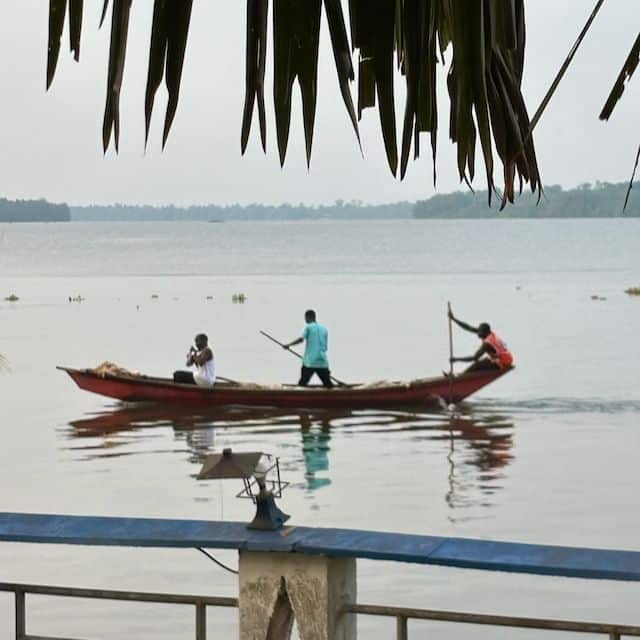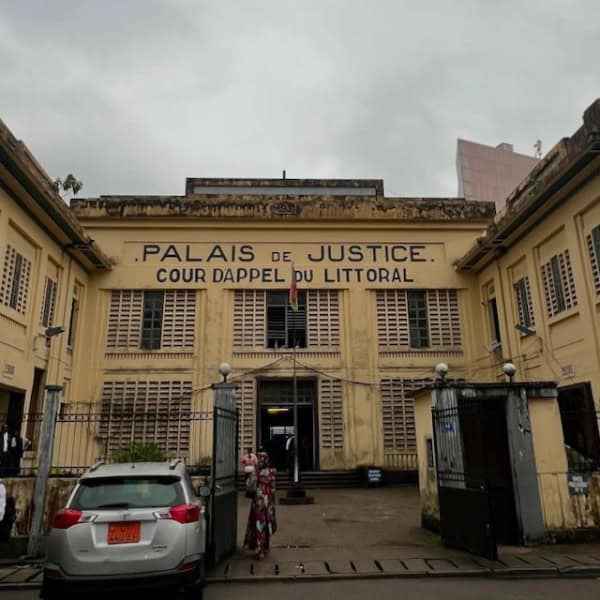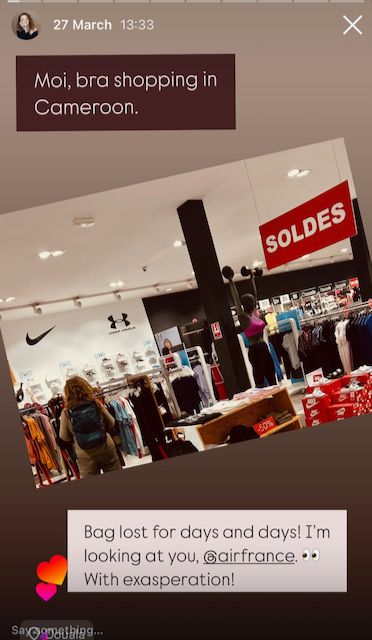

You are reading, despite the less than appealing headline? Good for you! It is not all bad. Not entirely. Not 100%. But…
In this post, I promised a little photo essay on Douala, a city I found to be a bit… overwhelming, shall we say.
One of my major grievances here in the biggest city in Cameroon (and in the entire CEMAC region), is very bad traffic infrastructure planning. Or is there actually a plan to it? Hard to tell. Here is just one example, and far from the worst:

Parking on the pavement, so pedestrians are forced into the street, where they risk their lives.
Walking in the centre of Douala feels like being in an episode of Squid Game, where the reward is simply surviving. Even playing Frogger with scooters in Saigon is child’s play compared to this.
But let’s move along with an open mind, checking out the see’s and do’s in this metropolis.
What to see and do in Douala
I am going to begin with this sculpture of General LeClerc, simply for the irreverent connection to ‘Allo ‘Allo! You will find him outside the central post office in the Bonanjo district, the city centre of Douala.
LeClerc

The LeClerc tank is named after this soldier
But what was his connection to Cameroon? Well, during World War II, he was DeGaulle’s personal envoy to the country, and all of Francophone Africa really. His mission was to gather support for Free France’s fight against Nazi Germany. Our man LeClerc played an important role in overthrowing the vicious Vichy government.
His real name was Philippe de Hauteclocque. LeClerc was his code name for clandestine operations. And he must have liked it, because after the war, he added it to his civilian name. Sadly that joy did not last long for him. LeClerc died on 28 November 1947, in a plane crash in Algeria. The statue here in Douala was put up the following year.
Monument to the Dead

Remember I talked a bit about how Cameroon once was a German colony, before the French and the English took over? This is a monument to the dead, specifically those who died during the Kamerun Campaign (1914 – 1918). That is when the French and the English arrived to take over and kick the Germans out. Some call it the monument to the unknown soldier, but the proper name is the Monument to the Dead.
Cathedral of Saint Peter and Paul

Built in 1936, Douala’s metropolitan cathedral is opposite the Mbappe Lepe stadium. It is a nice place for some peace and quiet – and, just as important, to get a break from the insane traffic. And the oppressive heat.


Filled with locals on a Friday late afternoon service
Across the street is the public cemetery, including 26 Commonwealth war graves.


La Pagode, or the Palace of King Bell

Modern Indian, pagoda style
Manga Ndumbe Bell built this pagoda as a residence for his family in 1905, when Cameroon was still under German rule. His son, Rudolf Douala Manga, lived here until he was arrested in 1914. The German colonial administrators wanted to move locals inland and expropriate their land, so that this would be a European-only settlement. Naturally, this was not popular with the public opinion, and Rudolf, educated in Germany and a man of means, led the opposition. As a result, the Germans executed him in 1914. He was the last of the Bell royal family.
The Sud Obelisk
In a roundabout next to the pagoda is this obelisk of reinforced concrete, covered in black marble and with a bit of gilded brass on top. On all four sides, you can see engraved in Latin and Arabic script, the names of other cities in the world that have obelisks. Some say obelisks represent the technology needed to communicate with the heavens, a link between heaven and earth.
I like obelisks, especially those of Ancient Egypt, and especially especially the obelisk of Hatshepsut, the female pharaoh, in Karnak – the tallest obelisk in all of Egypt. #girlpower
But I digress. This obelisk is also said to have a dialogue going with the top of the pagoda just behind it.

Contemporary public art in Douala
Marechal

If you are into watching sports, you will probably be familiar with Marechal, or Samuel Mbappé Léppé, one of the most famous African footballers of his time. The statue is next to the stadium named after him.
Colonial architecture in Douala

Formerly the Palace of Justice, this is now the Court of Appeal of the Littoral, one of the 10 regions of Cameroon. It is one of many examples of French colonial architecture here in Douala. (It is also not allowed to photograph this edifice, as it turns out. Publishing this anyway, as it is an interesting building.)

Here is an example of German colonial architecture. This Bethel (House of God), was built in 1899 by baptists from Berlin.
Fun fact: Douala was known as Kamerunstadt during the German occupation.
Shopping in Douala
The large Marché Central de Douala has traditional Cameroonian fabric and handwoven baskets, as well as African art, fruit and veg, cheap electronics, shoes, and probably everything else.
But I’m looking for replacement clothes, preferably in a proper indoor shop. A bit harder to find, although I hear there is a shopping mall – Le Douala Grand Mall – out by the airport. But I just can’t bear the thought of a taxi ride through the mad traffic, so this sporting goods shop in the city centre will have to do.

If you want a new carpet, however…

Douala eats and drinks
Douala’s eateries and drinkeries are redeeming features of this less than charming big city. How about we take a stroll along the waterfront, watch the boats and fisher folk – and try a local restaurant?
Jardins des Palétuviers
In Bonassama in the Bonabéri district by the Wouri River estuary, is Les Palétuviers Matanda, with a restaurant, a bar, a children’s playground, water activities, and a lovely garden. As the day fades, we stop by for dinner on my first night in town.


Not unexpectedly, service is not exactly fast and efficient –
– but this machoiron (a type of catfish) served whole is very tasty, and worth the wait.

Le Boj
I only stopped by Le Boj for a quick lunch, and we were practically the only ones here. However, if I had been in town longer, this is where I would go for an evening of fun and music. The atmosphere, even when mostly empty, brought to mind a couple of favourites: Metro Pub in Bishkek, and Le Kimmyz in Casablanca.
(No photos of Le Boj, I’m afraid. I snapped a few, but they became victims of that whole ‘my camera going AWOL in the RCA’-thing.)
So that concludes a rather hurried exploration of Douala. Didn’t love it, but am not saying I’ll never return.

Moving on! We are now nearing the actual goal of this Central African journey: RCA, La République Centrafricaine, one of the world’s most volatile and most difficult countries to travel to. Stay tuned!
All photos by David Røgler and myself.
Please visit:
Our Sponsor
